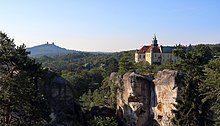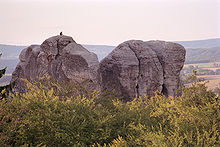Český ráj


The Český ráj (German: Bohemian Paradise ) is a low mountain range in northeastern Czech Republic on the central reaches of the Jizera . The landscape is mainly characterized by the well-known rock towns made of sandstone . Part of the region has been under nature protection as Chráněná krajinná oblast Český ráj since 1955, making it the oldest large-scale protected area in the country. Due to its special geological structure, the region was included in the networks of European and global geoparks in 2005, and has been a UNESCO Global Geopark since 2015 . The symbol of the Bohemian Paradise is Trosky Castle .
description
Position and extent
The protected landscape area is 181.5 km². The area belongs to mainly small rural communities in parts of the Semily , Mladá Boleslav and Jičín counties . However, there is no precise limit for the region. In essays, books and songs, cities such as Mladá Boleslav, Bezděz , Český Dub and Sychrov in the west, Bozkov in the north, Nová Paka and Konecchlumí in the east and Kopidlno , Staré Hrady and Libeň in the south are included in the region.
The protected area consists of three separate parts. The Geopark, designated in 2005, connects them and also includes the surrounding, unprotected landscape. It extends to 700 km². Finally, the Český ráj tourist region also includes the surrounding area with 126 municipalities and a total area of 1091 km². In the east the region borders on the foothills of the Giant Mountains , in the north the hilly landscape merges into the Jizera Mountains . To the west, the wooded areas of the Ralská Pahorkatina adjoin . The landscape in the south, which belongs to the Bohemian Pan , is flat and agricultural.
Geography and geology
The Bohemian Paradise belongs to the mountain formation Bohemian Table (Česká tabule). Sediments from the Mesozoic Sea form the bedrock for sandstone cliffs that were formed in the late Cretaceous period . The sandstone formations form extensive plateaus, which are roughly comparable to the rocky areas of Saxon Switzerland . The most famous rock cities are Hruboskalsko , Prachovské skály , Příhrazské skály , the Klokočské skály and Betlémské skály .
The sandstone plateaus are broken through by deep gorges. There are also isolated but striking volcanic cone mountains , extensive forests, cultivated land and ponds embedded in nature, including the Oborský rybník with 11.4 hectares of water. There is a good view from the viewpoints on the highest mountains Kozákov (744 m) and Kopanina (657 m).
Flora and fauna
In agriculture, arable farming is predominant, pastureland is less common. Coniferous plants dominate the forests. In places, mixed deciduous forests are still preserved. Valuable stocks of wild plants are found particularly in the canyon forests and wetlands. Eagle owls , falcons , common ravens and beech marten find favorable conditions in the rocks , while kingfishers , white storks and gray herons can be observed in the wetlands . The Bohemian Paradise is not an untouched natural, but a cultivated cultural landscape that has been inhabited and cultivated for several millennia , the value of which is seen primarily in the typical character of the sandstone cliffs. Larger industrial companies have never set up shop in the region. Ecological dangers are particularly threatening from agriculture and mountain sports tourism.
history
The region has been populated since the Neolithic Age. The earliest settlements were limited to the fertile valley plains, the rocks remained uninhabited with the exception of the Skály na Mužském . There were workshops for processing jasper on Mount Kozákov . Around 1100 BC A dense network of Lusatian culture settlements formed . The villages were only 1–2 kilometers apart, and numerous traces of settlement have been found on the rocks and especially in the caves. Fortified hilltop castles were built on Mount Mužský, in Hrubá skála and in Prachovské skály, among others. The system of well-protected and strategically favorably located fortified settlements remained in use until the Middle Ages, but without any evidence of settlement continuity.
By the 11th century AD at the latest, the settlement structure changed. The local nobility built numerous fortified mansions and castles at high altitudes, which still shape the landscape today.
The tourist development of the region began in the early 19th century in the area of Nová Ves (German Wartenberg), called Sedmihorky from 1966 . The air and cold water bath founded there in 1841 : Lázně Sedmihorky , named after the mineral spring “Sedmihorka”, offered guests particularly clean air and some cold healing springs, of which the Aloisienquelle is the most important. In the same year one of the first guests, the Czech poet Karel Havlíček Borovský , coined the name Bohemian Paradise , which quickly became established and which this region still bears today. Josef Zdenko Pryl wrote the first “Guide to the Bohemian Paradise” in 1885 at the instigation of the founder and director of the Sedmihorky Spa in Nová Ves, Dr. Antonín Vincenc Šlechta.
Many Bohemian artists found inspiration in Sedmihorky and the surrounding area. The composer Bedřich Smetana spent a good part of his last years here. From 1876 to 1884 he stayed in Jabkenice and composed, among other things, “Tábor” and “Blaník”, the last two symphonic poems from the cycle “ My Fatherland ” (Má Vlast).
Attractions

There are numerous cultural and historical monuments and natural attractions in the region. Worth mentioning are the castles Kost and Trosky , Vranov , Valdštejn , Zbiroh , Drábské světničky , Rotštejn , Valečov and the castles Hrubá Skála , Hrubý Rohozec and Humprecht .
The log-built farmhouses are considered to be particularly typical of the country, the best-known example is the Kopicův statek, previously Jirošova rychta, as an example of folk architecture in the village of Kacanovy, Okres Semily .
Mountain sports
The rocky areas Prachovské skály, Hrubá skála, Suché skály and Skály na Mužském are interesting for climbers . An important peak here is the mare (Kobyla) in Příhrazy. The baton , lighthouse , bandmaster and the dragon rocks are the most important peaks in the Hrubá skála. In Prachovské skály these are the raven towers , the Prachau needle and the Prachau hat . Climbing here has been going on since the twenties of the 20th century, initially mainly by Reichenberg and Dresden climbers. Later, especially after the Second World War , more and more local Czech climbers joined them.
It should be noted that after rain, due to the very soft rock, it is not allowed to climb for 48 hours. Exceptions are the rocks of the Suché skály, which are made of very solid sandstone.
places
The municipalities of Sobotka , Mladějov , Troskovice , Libošovice , Olešnice , Hrubá Skála , Karlovice , Kacanovy , Ktová , Vyskeř , Osek , Dobšín , Branžež and Kněžmost have come together in the Český ráj microregion .
See also
- Slovenský raj (German: Slovak Paradise )
literature
- Chráněná Území ČR. 1 Střední Čechy . Praha 1996, ISBN 80-902132-0-0 .
- Jan Filip: Dějinné počátky Českého ráje . Prague 1947.
Web links
- Literature and other media from and about Český ráj in the catalog of the National Library of the Czech Republic
- Homepage of the tourist region (German)
- Microregion homepage (Czech)
- Geopark homepage (Czech, English)
Remarks
- ↑ Josef Prošek, Eva Bílková: Cesky raj. ČTK press photo, Prague 1988, no p.
- ↑ Czech Statistical Office
Coordinates: 50 ° 31 ′ 11 ″ N , 15 ° 10 ′ 14 ″ E


